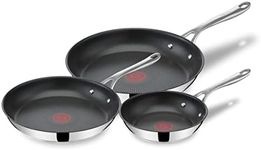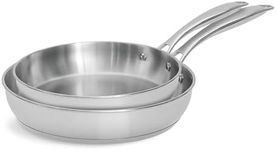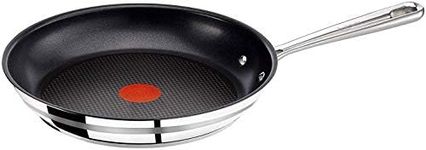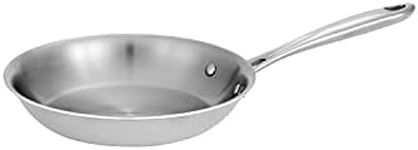Buying Guide for the Best Stainless Steel Pans
Choosing the right stainless steel pan can make a big difference in your cooking experience. Stainless steel pans are popular because they are durable, non-reactive, and versatile for many types of cooking. When shopping for a stainless steel pan, it's important to understand the key features that affect performance, ease of use, and longevity. By focusing on these important specifications, you can find a pan that matches your cooking style and needs.Material CompositionStainless steel pans are often made from different grades of stainless steel, with 18/10 (which means 18% chromium and 10% nickel) being the most common for cookware. This composition is important because it affects the pan’s resistance to rust and corrosion, as well as its shine and durability. Higher nickel content usually means better resistance to staining and a shinier finish. If you want a pan that stays looking good and resists rust, look for 18/10 or similar high-quality stainless steel. For those who are sensitive to nickel or want a slightly less expensive option, lower nickel content pans are available, but they may not be as resistant to corrosion.
Ply ConstructionPly refers to the layers of metal used in the pan’s construction. Common options are single-ply (just stainless steel), tri-ply (three layers, usually stainless steel with an aluminum or copper core), and even five-ply or more. This is important because stainless steel alone doesn’t conduct heat very well, so pans with an aluminum or copper core heat more evenly and prevent hot spots. If you do a lot of delicate cooking or want the best heat control, look for tri-ply or multi-ply pans. For basic tasks or if you don’t mind a little uneven heating, single-ply pans can work.
Pan ThicknessThe thickness of the pan affects how well it retains and distributes heat. Thicker pans are less likely to warp and provide more even cooking, but they are also heavier. Thin pans heat up quickly but can develop hot spots and may warp over time. If you want a pan that lasts and cooks food evenly, choose a thicker pan, especially if you plan to use it for searing or high-heat cooking. If you prefer something lightweight for quick tasks, a thinner pan might be easier to handle.
Handle DesignThe handle of a stainless steel pan affects comfort and safety. Some handles are hollow or have a special design to stay cool, while others may get hot during cooking. Riveted handles are more secure but can be harder to clean, while welded handles offer a smoother surface. If you often move your pan from stovetop to oven or need to lift heavy dishes, look for a comfortable, sturdy handle that stays cool. If easy cleaning is a priority, consider welded handles.
Lid TypeSome stainless steel pans come with lids, which can be made of stainless steel or glass. Lids help trap heat and moisture, making them useful for simmering or braising. Glass lids let you see your food without lifting the lid, but they can be heavier and more fragile. Stainless steel lids are more durable and oven-safe at higher temperatures. If you plan to use your pan for recipes that require covered cooking, consider the type of lid that best fits your needs.
Oven and Dishwasher SafetyNot all stainless steel pans are safe for the oven or dishwasher. Oven safety is important if you want to finish dishes in the oven or use your pan for roasting. Dishwasher safety makes cleanup easier, but frequent dishwashing can dull the finish over time. If you want maximum versatility, check the manufacturer’s guidelines for oven and dishwasher use, and choose a pan that matches your cooking and cleaning habits.

















